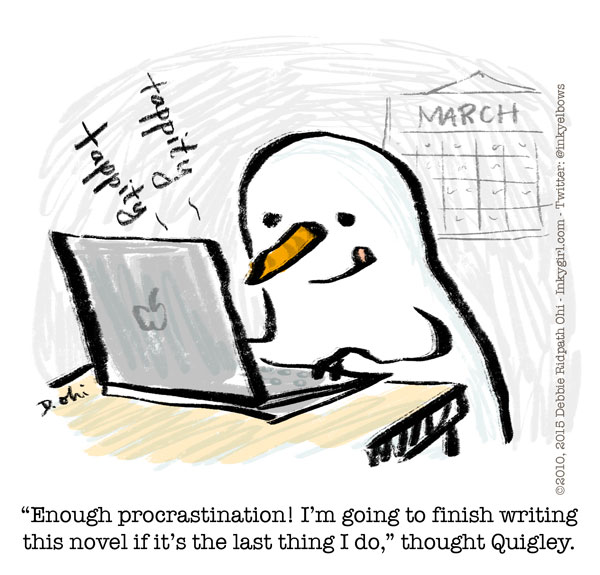new posts in all blogs
Viewing: Blog Posts Tagged with: surreal, Most Recent at Top [Help]
Results 1 - 16 of 16
How to use this Page
You are viewing the most recent posts tagged with the words: surreal in the JacketFlap blog reader. What is a tag? Think of a tag as a keyword or category label. Tags can both help you find posts on JacketFlap.com as well as provide an easy way for you to "remember" and classify posts for later recall. Try adding a tag yourself by clicking "Add a tag" below a post's header. Scroll down through the list of Recent Posts in the left column and click on a post title that sounds interesting. You can view all posts from a specific blog by clicking the Blog name in the right column, or you can click a 'More Posts from this Blog' link in any individual post.

I have actually broken my resolution not to make resolutions and am going to make a resolution! See my blog post on KidLitArtists.com: New Year's Resolutions and Realistic Goal-Setting For Children's Book Writers and Illustrators.
Happy New Year's, everyone!

By: Beth,
on 3/24/2015
Blog:
YALSA - Young Adult Library Services Association
(
Login to Add to MyJacketFlap)
JacketFlap tags:
National Library Legislative Day,
state legislature,
legislator,
elected official,
law maker,
News,
Advocacy,
Legislation,
Resolution,
bill,
advocate,
Add a tag
Has it crossed your radar yet that there's been a big shift in how laws are getting made? Last year state legislatures around the country passed 45,564 bills, compared with just 352 passed in Congress. That works out to an average of 911 bills per state. This change in the way laws are getting made means that we need to change the way we advocate for teens and libraries. Spring is the time of year when many state legislatures are in session. What can you (or your teen patrons) do to call their attention to the importance of libraries? YALSA has the answer! We have everything you need to reach out to your state legislators and ask them if they will sponsor a resolution in support of libraries. A resolution is not legislation or a bill--just a feel good message about libraries. Both Congress and state legislatures pass these types of warm fuzzies all of the time in an effort to make nice with the voters. YALSA has a few sample documents compiled into one file that you can adapt and use, including a sample resolution, emails and a press release. Access the MS Word file today for an easy way to raise awareness about libraries with the elected officials in your state!
If you want to learn more about what's going on at your state legislature, check out The 50 State Project, and find out what's happening with library related-legislation and/or get in touch with your state legislators by visiting http://cqrcengage.com/ala/chapters. And don't forget that National Library Legislative Day is May 5th! If you can't make it to Washington DC, ALA has several ways that you can participate virtually. Lastly, there are a bunch of advocacy resources on the YALSA web site at ala.org/yalsa/advocacy that you can use year round to advocate for teens and libraries.
-Beth Yoke


By:
Roberta Baird,
on 12/31/2013
Blog:
A Mouse in the House
(
Login to Add to MyJacketFlap)
JacketFlap tags:
illustration,
new year,
children's illustration,
Texas,
digital art,
roberta baird,
resolution,
artwork,
houston,
a mouse in the house,
www.robertabaird.com,
Add a tag

A New Year’s resolution is something that goes in one year and out the other.
~Author Unknown

I love the goals you've been posting!! Keep it up! Here's mine: Get back to a regular writing/blogging/reading schedule while handling the kiddos.
NOW as to book resolutions. I'm sure you've read as many series as I have if you read YA. I love them because if I care about a character, I don't want that character to disappear after one book. But I also can't deny that there's a beauty to a complete book. I'm thinking of ones like THE REPLACEMENT for example. As a matter of fact there have been many books lately - beautifully written books that I absolutely adore - that frustrate me at the end because I'm supposed to wait for the next installment, like the old Buck Rogers series. I like my books, even those within a series, to have a good wrap up. A nice finished feeling that leaves me wanting to visit the world again. What do you think? What examples can you think of?
My best to you in the coming year! Let's enjoy it together *clinks glass*.

By:
Roberta Baird,
on 12/31/2011
Blog:
A Mouse in the House
(
Login to Add to MyJacketFlap)
JacketFlap tags:
children's illustration,
digital art,
elderly,
www.robertabaird.com,
illustration,
new year,
Uncategorized,
roberta baird,
resolution,
artwork,
houston,
a mouse in the house,
Add a tag
A New Year’s resolution is something that goes in one year and out the other. ~Author Unknown

By:
Emma Walton Hamilton,
on 3/30/2011
Blog:
Emmasaries
(
Login to Add to MyJacketFlap)
JacketFlap tags:
Blog,
childrens books,
picture books,
Maurice Sendak,
Jane Yolen,
endings,
writing for children,
resolution,
Where the Wild Things Are,
Happy Endings,
plot structure,
Writing Childrens Books,
Children's Book Endings,
Add a tag
 And so we come to the last of my series of posts based on Jane Yolen’s list of “10 Words Every Picture Book Author Must Know.” Resolution… a fitting word to end the series with! Thank you, Jane, for providing us with such thought-provoking bounty (and two months worth of fodder for blog posts!)
And so we come to the last of my series of posts based on Jane Yolen’s list of “10 Words Every Picture Book Author Must Know.” Resolution… a fitting word to end the series with! Thank you, Jane, for providing us with such thought-provoking bounty (and two months worth of fodder for blog posts!)
Resolution shares its root with “resolve,” and in literary terms, it means the point within the story when the central conflict is worked out, or the problem is solved. Perhaps not exactly how the protagonist intended or hoped, but solved nonetheless, and in such a way that the hero has learned something and has changed or grown in the process.
The best resolutions satisfy a need created at the beginning of the book. This needn’t be happy – but it should feel both earned and inevitable, which is different from predictable. Rather than anticipating how the book will end, the reader should be pleasantly surprised, yet also feel “But of course it had to end that way!” And picture book endings must also be clear, as opposed to implied or left open; young readers may have difficulty choosing between possible outcomes.
Let’s look at an example. In the beginning of Where the Wild Things Are, Max’s mother is angry with him, and sends him to bed without any supper. The resolution occurs when Max decides, after a long ‘journey’ indulging in all his wild fantasies, to return home where “someone loves him best of all,” and discovers his dinner waiting for him. There’s that memorable last line: “And it was still hot.”
From this the reader understands that Max has been forgiven. The need established at the beginning of the book – for Max to know that he is still loved, and lovable – has been met. His problem – going to bed without supper – has been solved. But note that his Mother is not calling him to dinner at the family table. He has, after all, been naughty. Yet we worry for a child who goes to bed without any supper, so dinner in his room feels both earned and satisfying (at least, by the parenting standards of Maurice Sendak’s era!) And the fact that it’s still hot tells us that it wasn’t such a long journey after all. In fact, maybe just as short as a dream.
 The protagonist is always the character who is the most changed or transformed by the dramatic action in the story.
The protagonist is always the character who is the most changed or transformed by the dramatic action in the story.
At the Climax (the scene right before the Resolution at the end), the protagonist does something to "show" the ultimate change or transformation. Whatever she does at the Climax -- the crowning glory of the entire story -- she is unable to do anywhere else in the story. She has to first endure all the dramatic action that comes before in order to gain the abilities and skills and new understanding of herself.
Make sure the action the protagonist takes at the Climax reflects this inner and outer growth and ask yourself if she could have acted in the same way anywhere else in the story.
Yes? Then rethink the Climax.
No? Then you're good to go!
Happy New Year!
I'd like to begin with a tribute to
Jon Scieszka, outgoing Children's Literature Ambassador, guy's guy, writer's writer, kids' hero.
The drive to write is the drive to be connected, to move others in some fundamental way. Scieszka has said he writes to make kids laugh. As a mother of preschoolers, I say -- Bless him. As a writer, I say -- Bless him. As a teacher, I say again -- Bless him.
So, who will be the next Ambassador? I would offer a prize for the correct guess, but we already have some
big contest action this week. April's wonderful picture book (congrats on the latest kudos, April!) and her recent posts have frankly made me see New Year's Day in a new light. Yes, in 2010 I'd love to get fit, eat more healthfully, drink less, etc.... but in all honesty, the sacredness of the occasion has not been so clear to me at any time since I was seven years old. That was the year my parents went to a party and promised to wake me at midnight; but (and I understand completely now that I'm a parent of a hard-sleeping girl) they didn't have the heart to follow through. I remember the next morning -- mourning, wailing, gnashing of teeth, and many tears because I would never see the Old Year again. (And yes, 1979 was a great year!)
A facebook friend posted last week that she regarded this new decade with mixed feelings, as the last (nameless, generally reviled) one marked her marriage, new motherhood, and the advent of the "grown-up" years. I must say, I feel exactly the same.
I am not a habitual resolver, as I am far from resolute. Further, once I fall off the wagon (so to speak), I'm gone. Like most people, I respond far better to positive reinforcement than negative consequences; but of course, what better reward is there than the fruits of one's writing labors?
In the hope that posting it here will keep me honest or at least remotely on-task, here's my six-word resolution for the New Year. I resolve to:
Rest. Read. Play. Love. Laugh. Relax!
You will note that there is nary a mention of writing in my writing resolutions. However, in these early years of motherhood and consuming day job, I have often failed to nurture myself, to "fill the well" (as they say) and do the things that inspire. So I hope to make it a nine-word memoir and add write/revise/repeat to the tally. But I refuse to beat myself up if I don't make it there. Someday -- as you all have so often and kindly reminded me.
I just had two weeks' vacation from work. I had time to read! I downloaded the free Kindle for PC application. I am neck-deep in mysteries and kids' books and loving it. I resolved to update my website, and I did that, too. Being html-illiterate, I tried the
yahoo sitebuilder tool. It's garnered mixed reviews online, and I've hardly built a professional-quality site; but it's serviceable and, significantly, I can now update it myself. I've spent time reading about teaching and planning my syllabus for the upcoming semester. I've slept and played with the kids and relished the time we've had to just BE. And, not so coincidentally, the writing ideas are percolating like mad.
Today marks

By: Martha Alderson, M.A.,
on 11/9/2009
Blog:
Plot Whisperer for Writers and Readers
(
Login to Add to MyJacketFlap)
JacketFlap tags:
Climax,
Resolution,
End of the Beginning,
Halfway point,
character transformation Crisis,
how to write memoirs,
major scenes in novels,
screen plays,
Add a tag

Whether you like to work out the elements of your story on the page or are a pre-plotter, everyone benefits from a bit of periodic organization.
See how many of the key scenes you can identify in the story you're imagining, writing, or perfecting:
1) Set-up: The set-up you create in the Beginning makes the journey the protagonist undertakes in the Middle feel inevitable.
2) Inciting Incident: A moment, conflict, dilemma, loss, fear, etc. that forces the protagonist to take immediate action.
3) End of the Beginning: The protagonist's goal shifts or takes on greater meaning and turns the story in a new direction, launching the character into the actual story world itself.
4) Halfway Point: The moment the protagonist consciously makes a total commitment to achieving her goal and does something that signifies she has burned all bridges back and thus can only go forward.
5) Crisis: The all-is-lost moment.
6) Climax: Just as it looks as if all is permanently lost for the protagonist, she saves the day.
For more on key scenes:

By: Rebecca,
on 8/11/2009
Blog:
OUPblog
(
Login to Add to MyJacketFlap)
JacketFlap tags:
Rule,
sunset provision,
Byrd,
veto,
provision,
health-care reform,
Budget Act,
Budget Resolution,
Byrd Rule,
cloture,
presidential veto,
Reconciliation,
Resolution,
sunset,
Budget,
presidential,
Act,
health care,
reform,
Law,
Politics,
Current Events,
A-Featured,
filibuster,
majority,
Add a tag
Elvin Lim is Assistant Professor of Government at Wesleyan University and  author of The Anti-intellectual Presidency, which draws on interviews with more than 40 presidential speechwriters to investigate this relentless qualitative decline, over the course of 200 years, in our presidents’ ability to communicate with the public. He also blogs at www.elvinlim.com. In the article below he looks at reconciliation. See his previous OUPblogs here.
author of The Anti-intellectual Presidency, which draws on interviews with more than 40 presidential speechwriters to investigate this relentless qualitative decline, over the course of 200 years, in our presidents’ ability to communicate with the public. He also blogs at www.elvinlim.com. In the article below he looks at reconciliation. See his previous OUPblogs here.
There is a lot of hushed talk about using the Reconciliation procedure to pass health-care reform in the Congress these days, so Americans need to know something about this obscure parliamentary procedure, and what is at stake.
Reconciliation is an optional, deficit-reducing procedure that was created in the 1974 Congressional Budget Act. The Reconciliation process is a two-stage process. First, Reconciliation directives must be included in the annual Budget Resolution (as they were in the 2010 Budget Resolution passed on April 29). These directives instruct the relevant Congressional committees to develop (in this case, health-care) legislation by a specific date (in this case, October 15) to meet certain spending or revenue targets. The instructed committees then send their legislative recommendations to their respective Budget Committees, who then package all recommendations into one omnibus Reconciliation bill. Enter Stage 2, when this bill is then considered on the floor of both chambers of Congress under expedited procedures; of greatest political note is the 20-hour limit on debate on any Reconciliation measure, which effectively strips the minority party of the filibustering option in the Senate. That means the Democrats can pass health-care reform with a simple majority.
But there is an attendant cost to the majority party for using Reconciliation. The Byrd rule, passed in 1985, sets out the rules for what Reconciliation can and cannot be used for. In particular, it specifies that Senators will be allowed to raise a point of order against “extraneous” provisions in a Reconciliation bill which, among other things, “would increase the deficit for a fiscal year beyond those covered by the reconciliation measure.” Critically, cloture must be invoked to overcome a point of order. So the filibuster power is back.
Here’s the bottom line. Since the Budget Act states that the Reconciliation measure covers the next ten years, the Byrd Rule had the effect of allowing a point of order to be raised against any spending increase (or tax cut) that does not contain a ten-year sunset provision. That’s why the Bush tax cuts, passed via the Reconciliation route in 2001, 2003, and 2005, had sunset provisions written into them. If Democrats use Reconciliation, they will get a health-care bill, but it will expire.
Now let’s talk politics. There’s a debate within the debate that only seasoned politicos know about. Since the actual benefits of Reconciliation are mixed - a health-care bill can be passed with a simple majority in the Senate but it must have a sunset provision - the real power of Reconciliation is not in its actual usage, but in the mere threat of its usage.
The benefits of issuing the threat of going the Reconciliation route are akin to the threat of a presidential veto. The threat of a presidential veto sets the boundaries of permissible legislative action; it lets Congress know what is out-of-the-question and therefore powerfully guides legislative outcomes in the direction of the president’s preferences. By letting it be known that they will resort to Reconciliation if they had to, Democrats in Congress are incentivizing Republicans to be part of the making of a bi-partisan bill rather than be shut out of a purely partisan one. In making the threat, Democrats are specifying the costs of Republican non-compliance to the tune of: “if we let you stay in the kitchen, at least you can determine some of the ingredients in the cake. Make us shut you out and you won’t have even the slightest say.”
Like the presidential veto, the power of Reconciliation is maximal at the level of a threat. For between the time a threat is issued and the time when a bill is passed (via Reconciliation or not), there is a powerful incentive for Republican Senators to come back to the bargaining table because there is the distinct possibility that they could be shut out. Reconciliation is the Democratic antidote to the Republican Party becoming the “Party of ‘No’” For if Republicans keep saying “No,” then they box themselves into the plea of Nolo Contendere.
That is why different spokespersons for the Democratic Party are keeping the Republicans guessing and making sporadic and cryptic references to the Reconciliation possibility. And Republicans are trying to minimize the power of the threat by characterizing it as a no-go “nuclear option.” Unfortunately for Republicans, theirs is an empty threat because there is no Mutually Assured Destruction in this asymmetric power situation, and it is both a legal and political fact that, as the White House says, the Reconciliation option “is out there.” It is a win-win situation for Democrats to issue the threat, for if Republicans are unmoved by the threat, Democrats could materialize the threat and get what they wanted having known that an effort at bipartisanship had failed anyway.
What is missed in the debate out there now is that the effect of Reconciliation is already underway, for its power lies in its threat.

I realize I'm a bit late in wishing everybody a Happy New Year, but I do hope 2009 is off to a good start for everyone! It never occurred to me in the past to make resolutions, but this year I have a few, pretty ordinary ones:
- Get up in the morning at a reasonable time. I'm not at all a morning person and my hours tend to become more and more bizarre over the course of large projects. So I'm going to attempt to drag myself out of bed earlier than usual and get on a more 'normal' schedule.
- Get some regular exercise every day. I was doing pretty well with this until the holidays and then fell off the wagon and have yet to jump back on...
- Gain about seven pounds or so. That's right. I said gain.
- Art-wise, I'm still trying not to over-work paintings, painting too thickly and what-not. And trying to loosen up a bit.
So far, the first twelve days of 2009 find me failing miserably at the first three resolutions and showing spotty results with the fourth. But it's early still, plenty of time to right myself...
And I'm really late posting these pictures. These were taken on the side of the highway on my husband's drive to work:


Decorating this particular copse of trees along the 360 appears to be an annual tradition here in Austin.
Well, it's back to work for me now. A belated Happy Holidays to all!
We'd like to wish everyone a healthy, peaceful and happy new year.
I think my main resolution for 2009 will be to follow through on projects I start. I am a firm believer in the power of positive thinking, but if it's not carried through it won't work.
In the middle of 2008 I created a projection sheet. It lists the goals I want to accomplish along with wishes I'd like fulfilled. This was a great idea, but unfortunately I stopped reading it after a week or two.
The key to a projection sheet is to state your goals and wishes as if they already happened. The idea is if you tell yourself on a daily basis that these goals are fact they will become fact. They need to be written and said in present tense: I am healthy, not I want to be, I am. While this is not a miracle tool to use to acquire your heart's desire, it is a tool that can be used to help your mind and body to work in sync. This along with daily prayer can only benefit one's well being.
I will create a new projection sheet for 2009 and will try to be diligent about reading it and projecting it everyday.
I'll be hosting author/writer Dianne Sagan in Virtual Book Tours' January 02 schedule. Don't forget to stop by and visit.
THE END
The final 1/4 of the project.
The protagonist now knows what's not working and goes in pursuit of what does.
She is challenged every step of the way, only now in the End, she attempts to react in a new transformed way.
Each scene shows her finding her power little by little.
The Climax
The Climax comes almost at The End of the story itself.
The Climax is the biggest scene in the entire story.
The Climax is what the story is all about.
Each scene in the entire book has worked its way steadily toward this moment ~~ the Climax.
The Climax embodies the transformation.
The Climax shows the protagonist doing something she is now only able to do because of each of the tests and trials she underwent in the middle.
The Resolution
The Resolution is the final tie-up of everything.
The End builds at a fevered pitch to the Climax.
The energy drops off after that.
The Resolution brings final closure.

By:
Garden Painter Art,
on 4/23/2007
Blog:
Garden Painter Art
(
Login to Add to MyJacketFlap)
JacketFlap tags:
collage,
mixed media,
gnarly-dolls,
Garden Painter Art,
Kimberly Wlassak,
art prints,
surreal,
altered art,
ACEO,
Add a tag

By:
Garden Painter Art,
on 4/17/2007
Blog:
Garden Painter Art
(
Login to Add to MyJacketFlap)
JacketFlap tags:
dog,
collage,
mixed media,
gnarly-dolls,
Garden Painter Art,
Kimberly Wlassak,
surreal,
print,
twins,
Add a tag

I'm quickly stopping by to post a picture of one of my 3 newest collage prints. This is a 5" x 7" titled "Dog Girl On A Journey". I must admit, this has always been one of my personal favorites. I'm running only 3 to start with, and we'll see how that goes.
You can see this print in My Etsy Shop.
Thanks so much for taking a look.
Until Tomorrow:
Kim
Garden Painter Art
gnarly-dolls
















Happy New Year, Lisa!!!!!!!
I love this. The Replacement was awesome, and The Scorpio Races, and a host of other single titles. Libba Bray's for example. But the best series also do a good job of wrapping up, and showing an arc and all the other things that a good book is supposed to do. I'm thinking of If I Stay, for example, or Under the Never Sky, or Hunger Games. Katniss is so not the same person at the end of book one that she was at the beginning. Or Karou in Daughter of Smoke and Bone and Days of Blood and Starlight. On the other hand, as much as I loved The Raven Boys, I was disappointed that the depth wasn't there the same way it was in The Scorpio Races. As brilliant as she is, I'm suspecting that she is going to bring that depth in as an arc through the series though. Yes, I do dislike delayed gratification though, and the idea of having to wait two-and-a-half more years to see if there's a payout.
My New Year's Writing Resolution? To focus on writing the best books, the best chapters, the best scenes, the best sentences. That's all I can control.
Love you and sending hugs! Clink your glass for me tonight!
M.
Agreed. I love series, but there's nothing like a satisfying stand-alone read. I just finished THE DIFFERENT GIRL (which comes out in Feb.) and it definitely fell into that category. Happy New Year!
I agree completely. I feel manipulated by the ones that have cliffhanger endings, in fact I stopped reading one popular series after the first book (I won't name it) ended in mid-scene!
Like you, I want to be so enchanted that I wish to return to that world and unravel more of the mysteries, not be left dangling.
A book that really left me awed and satisfied from beginning to middle to end was Seraphina.
Wishing you a bright and satisfying New Year, Lisa!
I loved Fracture by Megan Miranda. There is a sequel, but Fracture was wonderful all by itself.
Loved THE REPLACEMENT. I am a series girl so unfinished endings when I know there is more to come doesn't bother me. Each book in the BEAUTIFUL CREATURES series has worked for me as its own unique story. Happy New Year.
Happy new year, Lisa! I'm not much of a series girl. Maybe it's my short attention span, but I like for a story to wrap up nicely, and then I move on to the next one.